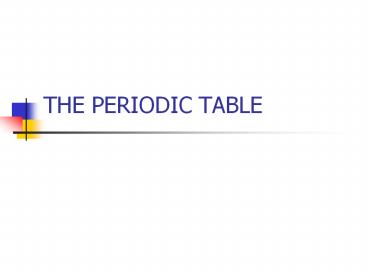THE PERIODIC TABLE - PowerPoint PPT Presentation
1 / 12
Title:
THE PERIODIC TABLE
Description:
THE PERIODIC TABLE THE SCIENTISTS Stanislao Cannizzarro (1860) Italian Founded a method for measuring atomic masses 2. Dmitri Mendeleev (1869) Russian` Arranged ... – PowerPoint PPT presentation
Number of Views:75
Avg rating:3.0/5.0
Title: THE PERIODIC TABLE
1
THE PERIODIC TABLE
2
THE SCIENTISTS
- Stanislao Cannizzarro (1860)
- Italian
- Founded a method for measuring atomic masses
3
2. Dmitri Mendeleev (1869)
- Russian
- Arranged elements in order of increasing atomic
mass. - Observed that properties were arranged
periodically - Was able to predict the existence of elements
based on gaps in his table.
4
3. Moseley (1911)
- Found that elements varied by the number of
protons in the nucleus. - Arranged elements based on atomic number.
5
PERIODIC LAW
- PERIODIC LAW states that the physical and
chemical properties of the elements are functions
of their ATOMIC NUMBER.
6
PERIODICITY
- A repeating/ predictable pattern of properties of
atoms as a function of their position on the
periodic table. - Periodicity is a result of the ELECTRON
CONFIGURATION of atoms and shows that elements
within the same GROUP/ FAMILY on the periodic
table tend to have similar PROPERTIES.
7
ALKALI METALS
- Group IA
- s1 electron configuration
- Combine vigorously with non-metals
- Extremely reactive
- Not found in nature as free elements
- Produce basic solutions when dropped into water.
- soft
8
ALKALINE EARTH METALS
- Group IIA
- s2 electron configuration
- Harder than group I metals
- Not found as free elements, but are commonly
found in nature in compounds - Very reactive not as reactive as alkali
9
TRANSITION METALS
- D- block
- Good conductors
- Lustrous
- Hard/ dense solids (except Hg)
- Form colored solutions.
- Palladium, platinum and gold are non-reactive.
10
P-BLOCK
- Lots of variation in properties
- Includes metals, metalloids, and non-metals.
- HALOGENS
- most reactive non-metals
- p5 electron configuration
11
NOBLE GASES
- Least reactive non-metals
- p6 electron configuration
- Full octet
12
F-BLOCK
- LANTHANIDE SERIES
- Rare earth elements
- Shiny metals
- ACTINIDE SERIES
- Unstable and radioactive
- Th-Np found in nature
- All others are man made































